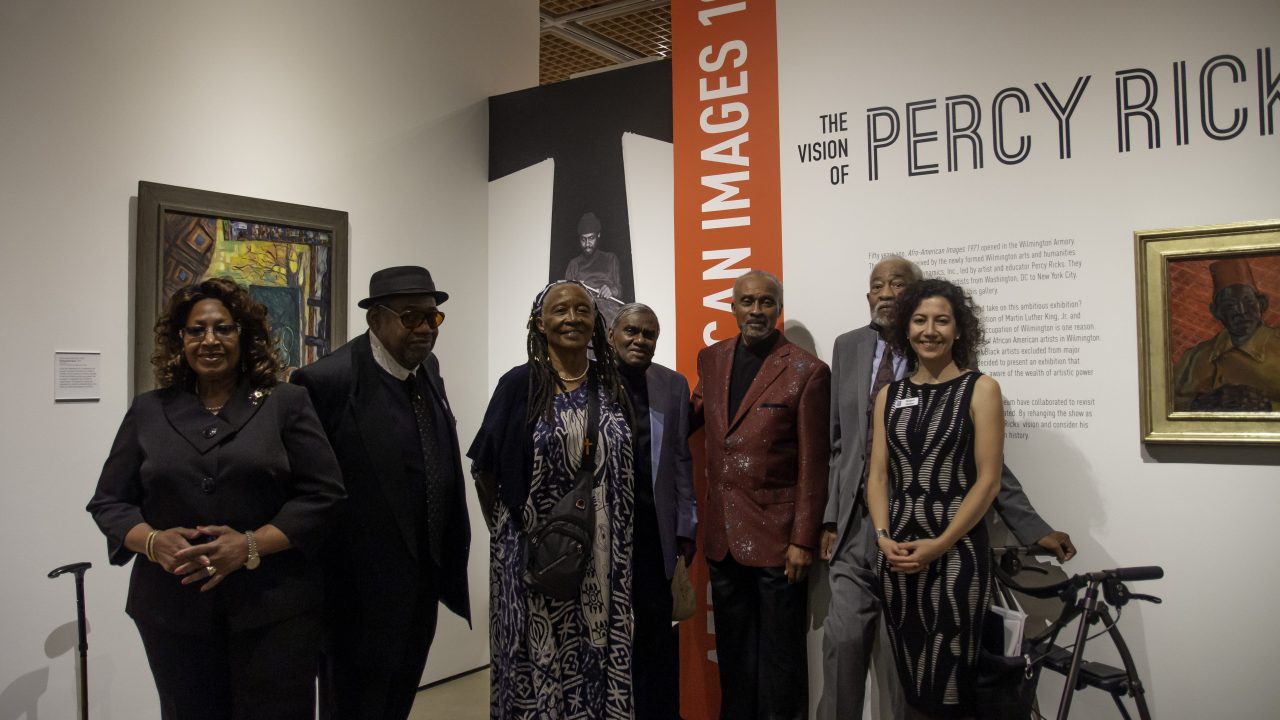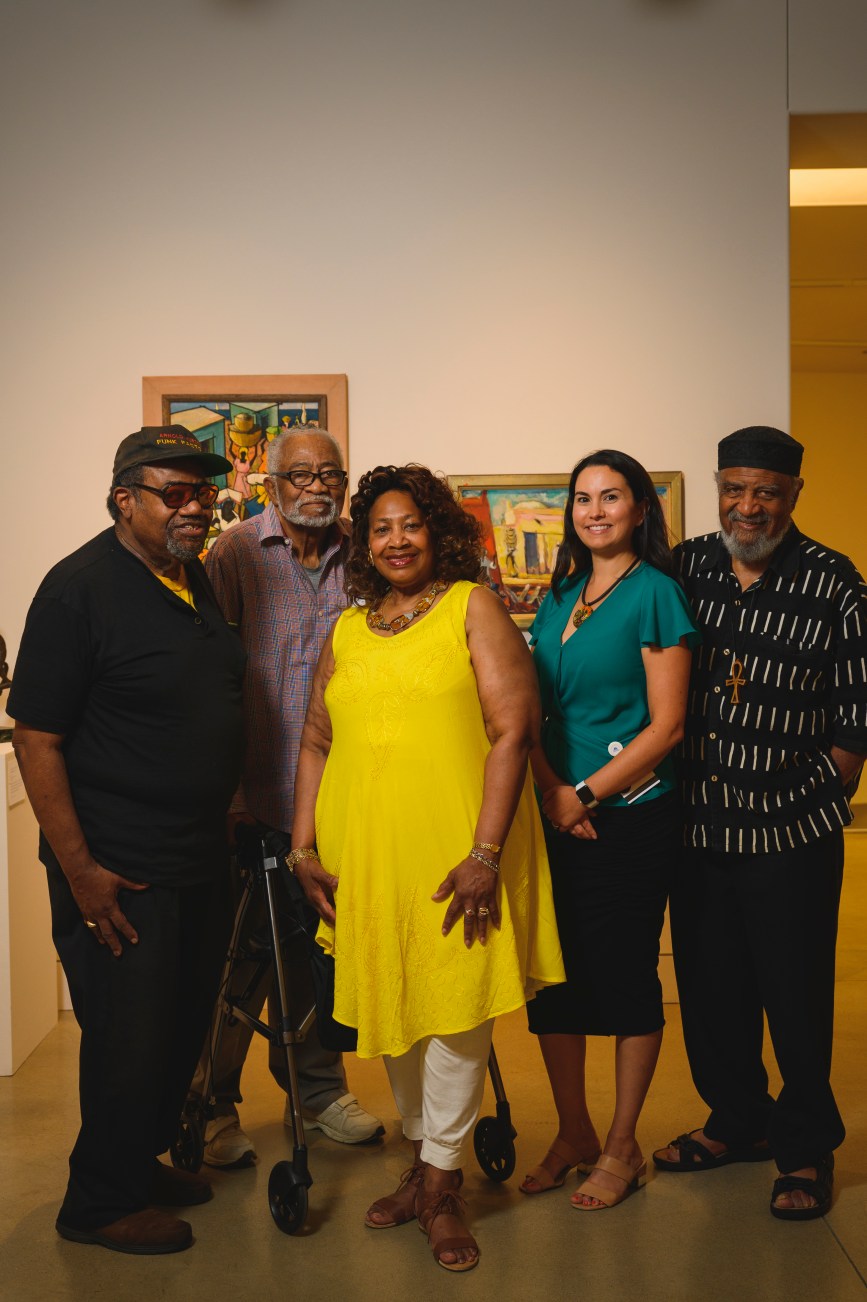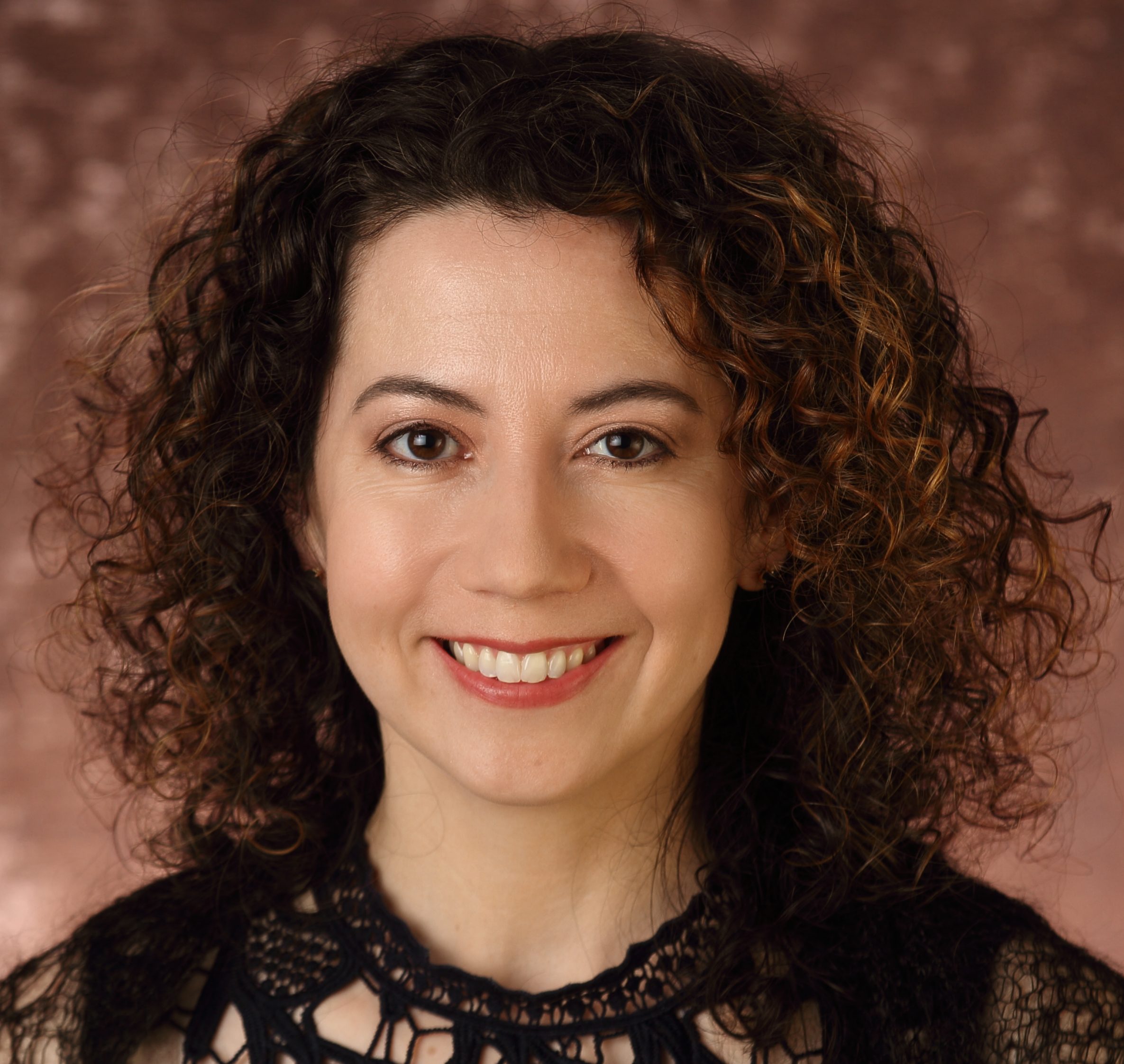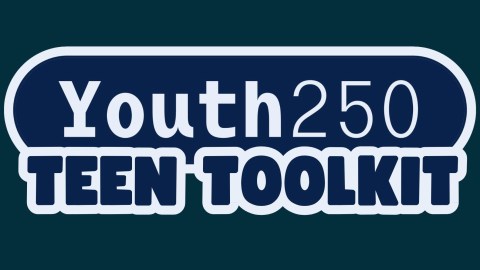
In February 1971, a newly formed Delaware organization, Aesthetic Dynamics Inc., presented its first major undertaking: an exhibition of over 130 works of art—drawings, prints, photographs, paintings, and sculpture—by sixty-six African American artists. The idea for the organization and its ambitious inaugural exhibition came from artist Percy Ricks, who wanted to emphasize the influence of African American artists in Wilmington, Delaware, at a poignant moment in history, just a few years after the traumatic 1968 assassination of Martin Luther King Jr. and the subsequent nine-month National Guard occupation of Wilmington.
Last year, Aesthetic Dynamics and the Delaware Art Museum collaborated to restage this momentous exhibition in DelArt’s galleries at its fiftieth anniversary. The restaging included most of the artists who participated in the 1971 show, many known locally—such as Humbert Howard, Simmie Knox, Edward Loper Sr., and Edward Loper Jr.—and others recognized nationally, including Romare Bearden, Sam Gilliam, Loïs Mailou Jones, Faith Ringgold, Alma Thomas, and Hale Woodruff. By rehanging the show as accurately as possible, the partnering organizations sought to examine the exhibition’s role in the Black Arts Movement and question why, despite its apparent success at the time, it had been largely neglected by historians in the decades that followed. As work on the exhibition progressed, however, it quickly began to take on deeper dimensions, prompting a reckoning with the museum’s institutional history of racism and exclusion and a reevaluation of how we approach our working processes.
A Pivotal Question from an Advisor
In December 2018, members of the advisory committee for the restaging of Afro-American Images gathered for the first time at the Delaware Art Museum. Included alongside representatives from DelArt and Aesthetic Dynamics were community members with backgrounds in African American art and history and with long affiliations with cultural organizations in Wilmington. As the group’s discussion began, it soon focused on the reasons for revisiting the historic show. Marilyn Whittington, Director Emerita for Delaware Humanities, asked what became a pivotal question: Why was the museum interested in doing this exhibition now, fifty years late?
She went on to remind staff of instances of institutional racism at the Delaware Art Museum. Ricks had requested the museum mount his exhibition there fifty years prior, and the museum had ignored his request. And Whittington referenced Simmie Knox, one of the artists in the exhibition, who removed his paintings from a later 1971 museum exhibition in protest of his poor treatment. The museum’s Director at the time, Bruce St. John, had responded by defining the museum as “basically a white institution” and placing the burden of change on the Black community.
Whittington’s question became a leading line of inquiry as DelArt staff, Aesthetic Dynamics representatives, and advisory committee members embarked on three years of intense planning and assessment leading up to the presentation of Afro-American Images 1971: The Vision of Percy Ricks, on view at the museum from October 23, 2021 to January 23, 2022.
What Led to These Comments Being Made to Staff?
Though this question became critical to the exhibition’s development, it may never have been spoken if not for the foundation of trust the museum had been intentionally building between itself and the community for years before. For nearly ten years, I have led a committed curatorial program dedicated to combatting historical amnesia by recovering Wilmington’s contemporary art history. While these efforts have been guided by industry standards and shifts in social concerns, much of the progress has been made through staff reflecting inward and looking out.
Prior internal work to address the museum’s culture of whiteness served as an important investment in transforming DelArt into a vital, civically engaged hub for our city. Through training in active listening and diversity, equity, accessibly, and inclusion, staff were given the tools to receive and translate knowledge they heard from the communities they support. Learning how to listen became as important as asking questions.
The museum had also prioritized seeking guidance from Black community leaders and reshaping the internal structures that guide knowledge exchange and decision-making. A precedent of convening advisory committees to guide exhibit planning and a commitment to centering community voices within museum interpretation led to a diversification of voices, from a single authoritative opinion to a chorus of perspectives.
DelArt’s institutional commitment to inclusion extended across staff, leadership, and board makeup and was shared with our stakeholders through exhibitions and programs and emphasized throughout every aspect of the museum’s work.
How Did Museum Staff Address the Feedback?
In the moment of Whittington’s comments, some of the staff in the meeting found it challenging to respond. It was clear that many were hearing about these past events for the first time. One white colleague recalls she found it difficult to serve as a representative of the museum in that moment, wondering how to respond to racism carried out before her time. She tried to deflect from the institutional-level examination the discussion required by bringing up an upcoming program at the museum that dealt with related topics, a response that felt inadequate in hindsight.
With time, however, staff began to see how crucial it was to absorb Whittington’s feedback and center it in how the exhibition moved forward. We leaned into inquiry. We had experience examining significant cultural and historic moments in Wilmington’s history though prior exhibitions such as Dream Streets: Art in Wilmington 1970–1990 and Black Survival Guide, or How to Live Through a Police Riot, but we had not yet turned a lens on the museum’s own history of the past fifty years, especially the role it had played in supporting or hindering civil rights movements. To address that question, we conducted research, surveying institutional archives, conducting oral history interviews, reviewing the public record by scouring historic newspapers, and reading everything published by Percy Ricks. We shared these documents—exhibition reviews, letters to the editor, curatorial memos—across the museum with colleagues, senior leadership, and the board.
Staff were able to demonstrate their research and knowledge to members of the advisory committee in subsequent meetings, as well as to the Black cultural leaders who had experienced the museum’s past institutional racism firsthand. In the end, the answer to Marilyn Whittington’s question came not in the form of a new initiative or cloaked defense, but in an acknowledgment, a first step of public admission of the role the museum has played in upholding institutional racism and excluding so many people and their creative voices.
The advisory committee also guided how we addressed this history, urging the museum to do the needed internal work first and to keep Percy Ricks’ legacy foremost in the exhibition. Thus, the exhibition’s narrative stays true to his vision, but alongside the original work, we tell the story of our own history of exclusion via object labels, panel text, and catalogue essays that clearly acknowledge the lack of support the museum extended to Ricks and his 1971 landmark project. And in the press preceding the exhibition and following its opening, the museum openly admitted its failures.
Changing the Ways We Work
The way of working we embraced with Afro-American Images directly opposes much of the traditional, rigid operations of museums. Traditional exhibition planning is structured by fixed timelines, budgets, and physical plans, with fundraising efforts carried out well in advance. But these systems, underpinned by what Tema Okun defines as white supremacy culture, often leave little room for outside voices, response to community inquiry or criticism, and changes in narrative. Without these things, museums cannot do the work necessary to transform, to be freed from their longstanding authoritative approach. We must acknowledge that the museum is a repository for knowledge, given in trust by its community. We are custodians of that knowledge, but not implicitly more knowledgeable than the communities we serve.
There are practical shifts to be made to become more responsive. First, ample time and space must be provided for a project to take shape and grow, for new research to be conducted, and for more voices to be added. Many grant funders have begun to accommodate this extended timeline or flexible narrative, especially when the collaborative approach is thoughtful and clearly articulated. Second, museums need to prioritize representing broad perspectives gathered from a diversity of experience in selecting the members of advisory committees. Third, it should be stated and acknowledged, in writing and verbally, that the group is committed to working collaboratively and the museum will respond to their guidance, honor their expertise, and compensate them for their time. Finally, the embrace of structures that lead to responsive actions must extend across all museum staff and must be prioritized at the leadership level.
Centering the expertise of community leaders who remember events as lived history is essential for ensuring they are more thoroughly documented. I believe this is the way to best counter the effects of historical amnesia. As advisory committee member Dr. Kelli Morgan reminded us, “There’s always been a critical mass—of people, art historians, collectors, writers, galleries—that have been protectors or guardians that keep [this work]. They’re the communities in which the work resides, and a lot of times those communities are ‘off the beaten path’ or out of major institutions. This show does a lot to demonstrate that we have our own frameworks. We have our own spaces outside of—or even adjacent to—the major Black institution. The show visualizes how other Black arts professionals have kept the work and the history alive…to illuminate the broader story and activity of so many other Black artists, historians, and curators.” This is an important reminder of the bias with which we view gaps in our knowledge. Just because we haven’t read about a moment in history does not mean it isn’t held firmly in the minds of those who lived it, or researched deeply by scholars whose voices have been silenced by white supremacy.
What Are the Opportunities to Be Gained?
There is much to be gained from addressing the institutional blind spots that all museums have. Perhaps the most obvious is knowledge! A deep knowledge of the museum’s history provides the opportunity to acknowledge past failures and fill gaps in the archive. Allowing time and space for a deep exploration of history and prioritizing community voices expands the stories the museum can share. By extension, this leads to a growth in prospective networks and future partnerships. We have seen the expansion in our list of collaborators, tangible evidence that we are engaging with more communities than ever before. As our external connections increase, so do our internal relationships. Changing the museum’s work culture brings the chance to amplify new voices and nurture listening and responsiveness across internal structures at every level.
But beyond this growth in knowledge, the biggest opportunity is to ensure the wrongs of the past are not perpetuated today. Marilyn Whittington’s question addressed a specific moment in the museum’s past, but it opens the door for us to investigate other blind spots in our history. We must continue to build on our foundation of trust so that community leaders are invited to ask and feel comfortable asking difficult questions, confident in the knowledge that the museum will respond.










Hello, wonderful article. Super informative with concrete strategies. thank you. In the photo, there are five people, but only four names listed. FYI
Thank you for catching this unintended omission. We are working on correcting.
I loved this article. I currently live in Southern Colorado and work for the Library District of Pueblo. These themes and strategies are recurring in our immediate environment. I am a Delaware native and always am intrigued by the history of Wilmington. I was born and raised in North Wilmington and never tire of learning about contemporary art news and history of this area.